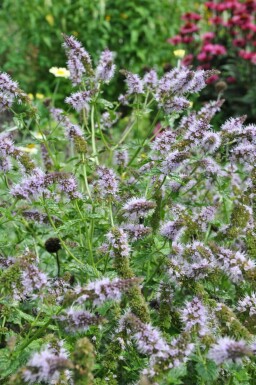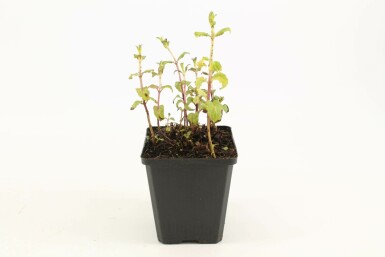

50cm




Updated on 10 September 2025
We regret to inform you that we are currently unable to ship orders to the United Kingdom. We anticipate being able to resume shipments at the beginning of 2026.
Mentha is a versatile herb known for its fragrant foliage and lilac or white flowers. Ideal for herb gardens, pots, or as ground cover around ponds, it grows quickly and attracts bees, making it a fantastic choice for both culinary and ecological gardens.


50cm




Mentha is a versatile choice for any garden, bringing a refreshing touch with its aromatic leaves. This edible herb thrives as a groundcover around ponds or in pots, making it a practical addition to fragrant borders. Its square stems and serrated, green leaves add texture, while the lilac-white flowers, blooming from June to September, attract bees and other pollinators. Imagine the joy of growing this fragrant perennial in an herb garden, where it not only delights the senses but also supports local wildlife. Discover the charm of Mentha and consider adding it to your garden for a fresh and reliable touch. For those interested, it's easy to buy mint plants in the UK or use them as container herbs.
Mentha, commonly known as mint, is a popular herb belonging to the Lamiaceae family. Known for its refreshing scent, mint comes in varieties like garden mint, spearmint, and peppermint. Widely used in cooking, mint enhances dishes with its unique flavour. This herb is notable for its role as a prime nectar plant, attracting bees, butterflies, and hoverflies in natural gardens. Its origins span globally, especially Europe and Asia, making it a versatile choice for gardens worldwide. The name "mint" comes from the Greek mythological figure Minthe, a nymph associated with the underworld. In Mediterranean and biblical traditions, mint represents cleansing, hospitality, and healing. As a perennial plant, mint features vigorous rootstock runners, enduring winter dormancy and regrowing quickly in spring. It thrives in moist and partially shaded areas. This adaptability makes mint perfect for borders, herb gardens, pots, and planters. Mint's culinary uses add value to any edible garden. For those looking to buy mint plants in the UK, it's an excellent container herb choice. Consider incorporating mint into your garden for both its ecological benefits and delightful flavour.
The Mentha is an aromatic garden plant that spreads rapidly. It is a perennial plant with vigorous rootstock runners that contribute to its invasive nature. The plant has a herbaceous form, and it can be found in borders, herb gardens, edible gardens, pots, planters, and natural gardens. Mint is especially valued in an insect corner because of its pollinator value. The plant's growth features square stems and opposite aromatic leaves that range from green to grey-green, with serrated edges. Mint is known for its rapid regrowth in spring after a period of winter dormancy, and it thrives in partial shade with enough moisture. The mint's lifecycle starts with quick regrowth in spring, becoming lush by early summer. It enjoys the summer months, when it blooms from July to September, displaying flowers in shades of white, lilac, purple, or pink. The blooming period depends on the climate, weather conditions, temperature, and plant age. Proper ground care and nurturing will ensure a healthy flowering period. Mint's blooming occurs during the warmer months, influenced by factors such as soil condition, light, and climate. For optimal growth, it can attain heights from 30 cm to 100 cm, depending on the species and environmental conditions. Whether grown for its culinary use or its fragrant properties, mint is a valuable addition to any garden, providing not only aesthetic appeal but also a bee-friendly environment.
Mentha, known for its oval, crenate leaves, displays a fresh green colour that sometimes shifts to a purple-green hue. The aromatic leaves not only add flavour but bring a delightful scent to the garden. Mentha is a hardy plant, tolerating temperatures from -34°C to -23°C, suitable for USDA zones 4 to 6. It's a spreading aromatic herb that thrives despite wet conditions or competition. Although mint is not toxic to children or pets, excessive ingestion can cause mild irritation. Yet, it remains a safe choice when growing around little ones and animals. Mentha is evergreen, but its vitality can fluctuate based on species, climate, and location. It's essential to note that regular cutting during summer is beneficial, keeping it neat and promoting more robust growth. The plant's origin and spreading rhizomes contribute to its heat and drought resistance. Its deep roots help it survive in variable soil moisture conditions, although it still requires some watering for optimal growth. Mentha's relationship with biodiversity is significant. The fragrant leaves and lilac or white flowering spikes attract insects, supporting garden ecosystems. It provides food and shelter for beneficial bugs, enhancing biodiversity and promoting garden health. This makes Mentha an excellent choice for those looking to enrich their garden while maintaining a balance with nature. Grow Mentha spicata in pots UK to control its spread and enjoy its many benefits.
Mint is a versatile and easy-to-grow herb that thrives in various garden settings. It can be an excellent addition to any garden space, providing both flavour and fragrance. Mint prefers a spot with partial shade to full sun, and well-drained soil to flourish.
Mint is a versatile plant that pairs well with different types of plants in the garden. It can be used in a herb garden, as a ground cover around ponds, or in pots. One interesting combination is mint with Melissa, also known as lemon balm. Both belong to the same family and share a fragrant aroma, which can create a soothing atmosphere. Another great pairing is mint with Foeniculum, or fennel. They thrive in similar conditions and attract beneficial insects with their flowers. Salvia is another attractive partner for mint, bringing vibrant colours and textures to the setting. Allium schoenoprasum, or chives, can add a delicate touch alongside mint due to their decorative purple blooms and shared hardiness. Lastly, Calendula, with its bright yellow and orange flowers, complements mint's green foliage and brings a pop of colour. These combinations not only look beautiful but are bee-friendly and add a fragrant touch to the garden. Mint spreads scent and quickly develops into an edible ground cover. Use these combinations to create a diverse and thriving garden environment, making the most of mint's perennial and aromatic qualities.
Mentha thrives in full sun to light shade, needing at least 4-6 hours of sun each day. Adequate sunlight ensures strong growth and flavourful leaves. However, too much shade can weaken the plant and reduce its aroma. Wind can affect Mentha, so planting it in sheltered spots or using windbreaks can help. A nutrient-rich, moist to wet soil is essential for mentha. Well-drained soil prevents root rot, while regular fertilisation supports vigorous growth. Maintain soil moisture as dry conditions can stress the plant. Consider the local climate and the amount of sunshine, as they impact soil drying. Mentha prefers a neutral to slightly acidic pH. Testing the soil pH and amending with lime or sulphur as needed can provide ideal conditions. Using raised beds or containers can help manage soil characteristics effectively. Adapting care practices based on local environmental factors ensures healthy growth for mint, spearmint, and peppermint.
Planting mentha is ideal in spring or autumn, especially on cloudy days. Potted plants can be planted year-round, except during frost. Those with a root ball or bare roots are best in spring or autumn. Planting distance depends on the species and size. Fast-growing mint might need spacing adjustments. Check plant properties on Heijnen product pages for plants per meter details. Preparing the soil is crucial for mint. Use a moisture-retentive, humus-rich, well-draining foundation. Heijnen planting soil is recommended for optimal results. Mentha prefers full sun to light shade and requires a moist environment with 4-6 sun hours daily. To plant mint, dig a hole twice the size of the pot. Place the plant, backfill with soil, and water thoroughly. Since mint is highly invasive, a root barrier can control spread. Regular watering and fertilisation keep mint thriving. This fragrant perennial, a bee-friendly herb, adds beauty and utility to any garden. Remember, regular pruning helps prevent it from overtaking the area. Enjoy mint as an edible herb and resilient groundcover.
Mint, known for its fresh aroma and taste, requires some care to flourish. Whether grown in a pot, border, or herb garden, mint thrives with the right maintenance. Understanding its needs can lead to a healthy and bountiful harvest.
Mentha is a valued plant in many gardens. The vibrant fresh green leaves sometimes show a touch of purple-green, adding visual interest. Mentha flowers with lilac, white, purple, or pink spikes, attracting bees and other insects, enhancing its role as a bee-friendly plant. The strong scent of this fragrant perennial is unmistakable, making it a popular choice for herb gardens and fragrant borders. Mentha spreads a strong scent and is a versatile herb plant. It grows quickly, forming herbaceous clusters with runners that can be invasive. This growth habit makes it excellent as ground cover around ponds or in pots. In autumn, while some plants fade, Mentha retains structure, adding texture to the garden. During winter dormancy, it prepares for quick regrowth in spring, ensuring fresh leaves are ready for harvest. As an edible herb, Mentha is versatile in the kitchen, offering flavour to dishes and refreshing teas. The plant thrives in moist areas and partial shade, making it adaptable to various garden conditions. Its fragrant leaves not only add scent but also serve as an excellent groundcover, integrating practicality with beauty.
Mint, or Mentha, is a versatile and aromatic herb that is popular for its culinary use and garden appeal. It can be grown in pots to control spreading, making it an excellent choice for container herbs. Mint flowers in summer and should be cut regularly to maintain its shape. There are many hybrid types available, each with unique characteristics and pollinator value. Here are some popular types of mint:
These popular and widely used types of mint are available for purchase online at Heijnen. Growing mint can enhance both the culinary and aesthetic qualities of any garden.
Mentha is a popular choice for many gardeners. It adds aroma and flavour to various dishes. Here are the benefits and challenges of growing this plant.
Advantages:
Disadvantages:
Proper soil preparation and placement, along with correct care and timely fertilisation, can reduce the risk of pests and diseases. Keeping Mentha well-maintained ensures optimal growth and blooming.
Mentha is a must-have for any herb garden. It thrives in pots and as a fragrant border. When looking to buy mint plants in the UK, consider Heijnen for a wide range of hybrid types. The culinary use of mint is vast, making it a versatile choice for both kitchen and garden. It creates a lovely ground cover around ponds and acts as a fast grower, ensuring a lush display throughout the season.
The advantages of mint plants are numerous. As a bee plant, they contribute significantly to pollinator value. Mint is also a prized edible herb, perfect for teas, desserts, and savoury dishes. Regular cutting ensures a bushy growth and enhances summer flowering. Container herbs like Mentha are ideal for limited spaces, allowing freshness at your fingertips.
Order your refreshing Mentha (Mint) from Heijnen and enjoy scent, flavour, and insect appeal in one plant.
We would like to provide some tips on how to plant and care for a Mentha. By following these tips, you can be sure to enjoy your Mentha for a long time.
Mentha thrives best in a nutrient-rich, moist to wet soil. A location offering partial shade to full sun is ideal, with the plant enjoying at least 4-6 hours of sunlight daily. It's important for the soil to be well-drained to avoid waterlogging, although Mentha can tolerate wetter conditions. Planting in spring or autumn during cloudy weather is recommended for optimal establishment. The right spot will lead to vigorous growth, richer blooms, healthier foliage, and increased resistance to environmental stress. Mentha can adapt to different conditions, spreading through rhizomes and handling competition well. This versatility makes it suitable for various garden applications, such as in herb gardens, as ground cover around ponds, or in pots and planters. Ensuring the correct standplaats is crucial for the plant’s overall success and vitality.
Proper soil preparation is vital when planting Mentha. Begin by loosening the soil to improve water drainage and mix in organic materials like compost to provide essential nutrients. This preparation ensures healthy growth and makes it easier for roots to establish. Importantly, pots-grown mint can be planted year-round, avoiding frost periods. For clump plants, spring or autumn is ideal. After planting, water the mint regularly until it is well-rooted. The size of the plant determines how many can be planted per square metre. A well-prepared ground encourages vigorous growth and strong roots, essential for a thriving mint plant. Remember, mint thrives in nutrient-rich, moist soil with partial shade, so choose the location carefully. Regular pruning will keep the plant manageable and prevent it from becoming too invasive. Caring for mint this way will ensure it remains a fragrant, bee-friendly addition to the garden.
Mint, particularly Mentha, benefits significantly from timely fertilisation. Fertilising in the spring supports vigorous growth and enhances both vitality and overall plant health. Using an organic or organic-mineral fertiliser from Heijnen promotes lush growth and abundant bloom, ensuring the mint remains robust. For optimal results, fertilise mint twice a year: once in the spring and, if harvesting heavily, a top-up in mid-summer. The amount of fertiliser needed depends on the size of the plant, so adjust accordingly. Fertiliser should be absorbed after being watered into the soil. During dry periods, ensure the garden is watered to help nutrients reach the roots efficiently. This careful approach to feeding mint helps mint thrive, maintaining its fresh green or purple-green leaves and vibrant blooms.
Mentha, commonly grown in gardens, benefits from regular pruning. This helps manage its vigorous growth and prevents it from overtaking other plants. Pruning also encourages new, healthy leaves, enhancing the plant's overall aroma and flavour. The best time to prune mint is during the growing season, typically from late spring to early summer. It's advisable to repeat this process every few weeks. Use sharp secateurs or a garden knife for the task, as good tools make clean cuts and prevent damage. Regular cutting back is essential to maintain the desired shape and size. When pruning, ensure to remove the top part of the plant to prevent it from spreading too wide. Keeping the mint well-pruned ensures it remains a delightful and organised addition to any garden.
Mentha requires frequent watering as it thrives in consistently moist soil. High water need is typical for mint, so checking the soil regularly is important. Young mint plants need regular watering to establish roots, after which water them mainly in dry spells. When watering, deeply soaking the soil is more beneficial than giving small amounts daily. Watering mint early in the morning or late afternoon helps reduce evaporation. Ensure excess water drains well, whether mint is in the ground, pots, or containers. Drip irrigation works well once the plant is established, but newly planted mint still needs additional watering. Mint has low drought tolerance, so it wilts quickly if the soil dries. Proper watering keeps mint healthy and ensures robust growth.
Mentha is a popular herb known for its refreshing scent. It's often used in cooking due to its versatile flavour. This plant grows quickly, making it a favourite in gardens. Its fragrant foliage attracts bees, adding ecological value. The name comes from Minthe, a Greek nymph, symbolising cleansing and hospitality. While it's not toxic, consuming large amounts may cause irritation. Mint thrives in well-drained soil and partial sunlight.
Mentha can be easily divided to help rejuvenate the plant and maintain its health. Dividing Mentha is important for removing old plant parts and encouraging new growth. The process of division improves growth and helps control the spread of mint. To divide Mentha, dig up the plant, remove any old parts, and replant the younger sections. This should be done every two to three years. The best time to divide is in the autumn, although spring is also suitable. Use a sharp spade or garden fork for the best results. Regular division keeps the plant healthy and productive, offering fresh mint for culinary use and other purposes.
Mint is a fast-growing herb known for its aromatic leaves and lilac-white flowers. It's versatile in the kitchen and garden, making it perfect for adding fresh flavour to dishes. Mint serves as a ground cover, attracting bees, butterflies, and hoverflies. Its fragrant foliage and vibrant blooms delight both gardeners and insects. Order your refreshing Mentha (Mint) from Heijnen and enjoy scent, flavour, and insect appeal in one plant.
